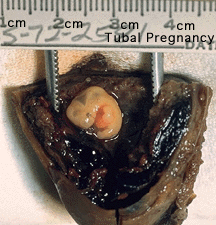Ectopic Implantation Research: Difference between revisions
mNo edit summary |
mNo edit summary |
||
| Line 4: | Line 4: | ||
Ectopic pregnancy is a high-risk maternal medical condition with an approximate incidence of 1.5 to 2 % in reported pregnancies. There is some indication that the incidence may be increasing (United States has increased from 4.5 per 1,000 pregnancies in 1970 to an estimated 19.7 per 1,000 pregnancies in 1992<ref><pubmed>7823895</pubmed></ref>) | Ectopic pregnancy is a high-risk maternal medical condition with an approximate incidence of 1.5 to 2 % in reported pregnancies. There is some indication that the incidence may be increasing (United States has increased from 4.5 per 1,000 pregnancies in 1970 to an estimated 19.7 per 1,000 pregnancies in 1992<ref><pubmed>7823895</pubmed></ref>) | ||
This is collaborative research between clinical researchers from the Women and Childrens Hospital (RHW), basic researchers from the School of Medical Scoences (SoMS), and research support from the HSA Biobank and Bioanalytical Mass Spectrometry Facility ( BMSF). | |||
Our research group has established a uterine tube Biobank and cell culture techniques in order to investigate factors and markers associated with tubal ectopic pregnancies. This page introduces the project and provides some introductory information for students who may wish to carry out an Honours, Independent Research Project or higher degree in the research laboratory. Click my image to get lab contact information. | Our research group has established a uterine tube Biobank and cell culture techniques in order to investigate factors and markers associated with tubal ectopic pregnancies. This page introduces the project and provides some introductory information for students who may wish to carry out an Honours, Independent Research Project or higher degree in the research laboratory. Click my image to get lab contact information. | ||
| Line 9: | Line 12: | ||
:'''Links:''' [[ | :'''Research Links:''' [https://research.unsw.edu.au/people/dr-mark-hill Dr Mark Hill] | [https://research.unsw.edu.au/people/professor-william-ledger Professor William Ledger] | [http://www.seslhd.health.nsw.gov.au/rhw/ Royal Hospital for Women] | [http://medicalsciences.med.unsw.edu.au SOMS] |[http://www.tcrn.unsw.edu.au/hsa HSA Biobank] | [http://www.bmsf.unsw.edu.au BMSF] | | ||
:'''Ectopic Page Links:''' [[Implantation]] | [[Week 2]] | [[Placenta - Abnormalities]] | [[Trophoblast]] | [[Trophoblast - Protein Expression]] | |||
==Some Recent Findings== | ==Some Recent Findings== | ||
[[File:Tubal_pregnancy.gif|thumb|Tubal Pregnancy]] | [[File:Tubal_pregnancy.gif|thumb|Tubal Pregnancy]] | ||
| Line 76: | Line 81: | ||
'''Search Pubmed:''' [http://www.ncbi.nlm.nih.gov/sites/entrez?db=pubmed&cmd=search&term=ectopic%20pregnancy ectopic pregnancy] | [http://www.ncbi.nlm.nih.gov/sites/entrez?db=pubmed&cmd=search&term=ectopic%20implantation ectopic implantation] | [http://www.ncbi.nlm.nih.gov/sites/entrez?db=pubmed&cmd=search&term=tubal%20pregnancy tubal pregnancy] | [http://www.ncbi.nlm.nih.gov/sites/entrez?db=pubmed&cmd=search&term=tubal%20implantation tubal implantation] | '''Search Pubmed:''' [http://www.ncbi.nlm.nih.gov/sites/entrez?db=pubmed&cmd=search&term=ectopic%20pregnancy ectopic pregnancy] | [http://www.ncbi.nlm.nih.gov/sites/entrez?db=pubmed&cmd=search&term=ectopic%20implantation ectopic implantation] | [http://www.ncbi.nlm.nih.gov/sites/entrez?db=pubmed&cmd=search&term=tubal%20pregnancy tubal pregnancy] | [http://www.ncbi.nlm.nih.gov/sites/entrez?db=pubmed&cmd=search&term=tubal%20implantation tubal implantation] | ||
==External Links== | |||
{{External Links}} | |||
* [http://www.seslhd.health.nsw.gov.au/rhw/ Royal Hospital for Women] (RWH) | |||
* [http://medicalsciences.med.unsw.edu.au School of Medical Sciences] (SoMS) | |||
* [http://www.tcrn.unsw.edu.au/hsa HSA Biobank] | |||
* [http://www.bmsf.unsw.edu.au Bioanalytical Mass Spectrometry Facility] (BMSF) | |||
Revision as of 13:34, 2 September 2014
Introduction
Ectopic pregnancy is a high-risk maternal medical condition with an approximate incidence of 1.5 to 2 % in reported pregnancies. There is some indication that the incidence may be increasing (United States has increased from 4.5 per 1,000 pregnancies in 1970 to an estimated 19.7 per 1,000 pregnancies in 1992[1])
This is collaborative research between clinical researchers from the Women and Childrens Hospital (RHW), basic researchers from the School of Medical Scoences (SoMS), and research support from the HSA Biobank and Bioanalytical Mass Spectrometry Facility ( BMSF).
Our research group has established a uterine tube Biobank and cell culture techniques in order to investigate factors and markers associated with tubal ectopic pregnancies. This page introduces the project and provides some introductory information for students who may wish to carry out an Honours, Independent Research Project or higher degree in the research laboratory. Click my image to get lab contact information.
- Research Links: Dr Mark Hill | Professor William Ledger | Royal Hospital for Women | SOMS |HSA Biobank | BMSF |
- Ectopic Page Links: Implantation | Week 2 | Placenta - Abnormalities | Trophoblast | Trophoblast - Protein Expression
Some Recent Findings
|
|
| More recent papers |
|---|
|
This table allows an automated computer search of the external PubMed database using the listed "Search term" text link.
More? References | Discussion Page | Journal Searches | 2019 References | 2020 References Search term: Ectopic Pregnancy <pubmed limit=5>Ectopic Pregnancy</pubmed> |
About Ectopic Pregnancy
The risk factors for tubal ectopic pregnancy include: tubal damage by infection (particularly Chlamydia trachomatis) or surgery, smoking and in vitro fertilization therapy. Prolonged tubal damage is often described as pelvic inflammatory disease and "scarring" can affect the cilia-mediated transport of the blastocyst during the first week of development. This is also the most common cause of pregnancy-related deaths in the first trimester. A recent United Kingdom enquiry into maternal deaths[2], identified ectopic pregnancy as the fourth most common cause of maternal death (73% of early pregnancy deaths).
Ectopic sites are named according to the anatomical location: Tubal (Ampullary, Isthmic, Cornual), Cervical and Ovarian. A study of 1800 surgically treated ectopics between 1992 and 2001 identified implantation sites by frequency: interstitial (2.4%), isthmic (12.0%), ampullary (70.0%), fimbrial (11.1%), ovarian (3.2%) or abdominal (1.3%).[3]
International Classification of Diseases
The International Classification of Diseases (ICD) World Health Organization's classification used worldwide as the standard diagnostic tool for epidemiology, health management and clinical purposes.
The two main codes cover O00 Ectopic pregnancy and O01 Hydatidiform mole.
Note that there is an additional code covering complications of the clinical treatment O08 Complications following abortion and ectopic and molar pregnancy This code is provided primarily for morbidity coding. For use of this category reference should be made to the morbidity coding rules and guidelines in Volume 2.
- Links: O00 Ectopic pregnancy | O01 Hydatidiform mole | Chapter XV Pregnancy Childbirth | International Classification of Diseases
Methotrexate
(MTX, amethopterin) Drug with several different uses including the treatment of ectopic pregnancy[4] and for the induction of medical abortions. Acts as a antimetabolite and antifolate (folic acid antagonist) drug that inhibits DNA synthesis in actively dividing cells, including trophoblasts, and therefore has other medical uses include cancer and autoimmune disease treatment. Treatment success in ectopic pregnancy relates to serum β human chorionic gonadotropin (β-hCG) concentration.
- Comparison of double- and single-dose methotrexate protocols for treatment of ectopic pregnancy (EP)[5]
- Links: Medline Plus
References
Reviews
<pubmed>20071358</pubmed> <pubmed>20023297</pubmed> <pubmed>16595714</pubmed>
Articles
<pubmed>7194809</pubmed> <pubmed>19978839</pubmed>
Search Pubmed
Search Pubmed: ectopic pregnancy | ectopic implantation | tubal pregnancy | tubal implantation
External Links
External Links Notice - The dynamic nature of the internet may mean that some of these listed links may no longer function. If the link no longer works search the web with the link text or name. Links to any external commercial sites are provided for information purposes only and should never be considered an endorsement. UNSW Embryology is provided as an educational resource with no clinical information or commercial affiliation.
- Royal Hospital for Women (RWH)
- School of Medical Sciences (SoMS)
- HSA Biobank
- Bioanalytical Mass Spectrometry Facility (BMSF)
Glossary Links
- Glossary: A | B | C | D | E | F | G | H | I | J | K | L | M | N | O | P | Q | R | S | T | U | V | W | X | Y | Z | Numbers | Symbols | Term Link
Cite this page: Hill, M.A. (2024, April 16) Embryology Ectopic Implantation Research. Retrieved from https://embryology.med.unsw.edu.au/embryology/index.php/Ectopic_Implantation_Research
- © Dr Mark Hill 2024, UNSW Embryology ISBN: 978 0 7334 2609 4 - UNSW CRICOS Provider Code No. 00098G


